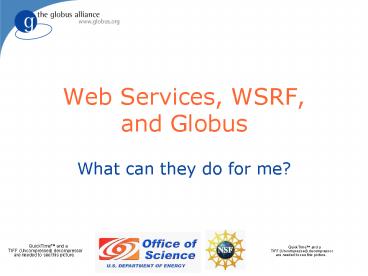Web Services, WSRF, and Globus PowerPoint PPT Presentation
1 / 17
Title: Web Services, WSRF, and Globus
1
Web Services, WSRF, and Globus
- What can they do for me?
2
Stateless vs. Stateful Services
FileTransferService
Client
move (A to B)
move
- Without state, how does client
- Determine what happened (success/failure)?
- Find out how many files completed?
- Receive updates when interesting events arise?
- Terminate a request?
- Few useful services are truly stateless, but WS
interfaces alone do not provide built-in support
for state
3
FileTransferService (without WSRF)
FileTransferService
Client
move (A to B) transferID
move
whatHappen
state
tellMeWhen
cancel
- Developer reinvents wheel for each new service
- Custom management and identification of state
transferID - Custom operations to inspect state synchronously
(whatHappen) and asynchronously (tellMeWhen) - Custom lifetime operation (cancel)
4
WSRF in a Nutshell
- Service
- State representation
- Resource
- Resource Property
- State identification
- Endpoint Reference
- State Interfaces
- GetRP, QueryRPs, GetMultipleRPs, SetRP
- Lifetime Interfaces
- SetTerminationTime
- ImmediateDestruction
- Notification Interfaces
- Subscribe
- Notify
- ServiceGroups
Service
GetRP
GetMultRPs
EPR
EPR
EPR
SetRP
QueryRPs
Subscribe
SetTermTime
Destroy
5
FileTransferService (w/ WSRF)
FileTransferService
Client
createResource (A to B) EPR
createResource
getRP
queryRPs
destroy
- Developer specifies custom method to
createResource and leaves the rest to WSRF
standards - State exposed as Resource Resource Properties
and identified by Endpoint Reference (EPR) - State inspected by standard interfaces (GetRP,
QueryRPs) - Lifetime management by standard interfaces
(Destroy)
6
The Introduce Authoring Tool
- Define service
- Create skeleton
- Discover types
- Add operations
- Configure security
- Modify service
Generates GT4-compatible WebServices
Introduce Hastings, Saltz, et al., Ohio State
University
7
Globus Philosophy
- Globus was first established as an open source
project in 1996 - The Globus Toolkit is open source to
- Allow for inspection
- for consideration in standardization processes
- Encourage adoption
- in pursuit of ubiquity and interoperability
- Encourage contributions
- harness the expertise of the community
- The Globus Toolkit is distributed under the
(BSD-style) Apache License version 2
8
dev.globus
- Governance model based on Apache Jakarta
- Consensus based decision making
- Globus software is organized as several dozen
Globus Projects - Each project has its own Committers responsible
for their products - Cross-project coordination through shared
interactions and committers meetings - A Globus Management Committee
- Overall guidance and conflict resolution
9
http//dev.globus.org
Guidelines(Apache Jakarta) Infrastructure(CVS,
email,bugzilla, Wiki) Projects Include
10
Open Source ! Free time
- Globus development is well-funded
- The open source model facilitates contributions
- NSF and DOE sponsor Globus development at several
institutions via multiple grants, totaling
gt5M/yr - Non-U.S. science agencies also contribute to
Globus development - Corporations also sponsor developers
- NSF explicitly funds Globus improvements
- CDIGS Community-Driven Improvements to Globus
Software
11
Globus Technology Areas
- Core runtime
- Infrastructure for building new services
- Security
- Apply uniform policy across distinct systems
- Execution management
- Provision, deploy, manage services
- Data management
- Discover, transfer, access large data
- Monitoring
- Discover monitor dynamic services
12
Globus Projects
GlobusToolkit
OGSA-DAI
MPICH G2
Data Rep
Replica Location
Java Runtime
MyProxy
Delegation
GridWay
CAS
GridFTP
MDS4
C Runtime
GSI- OpenSSH
Incubation Mgmt
Reliable File Transfer
GRAM
Python Runtime
C Sec
GT4 Docs
Incubator Projects
Swift
MonMan
GEMLCA
Cog WF
GAARDS
Virt WkSp
MEDICUS
NetLogger
OGRO
GDTE
UGP
GridShib
Dyn Acct
Gavia JSC
DDM
Metrics
LRMA
HOC-SA
PURSE
Introduce
WEEP
Gavia MS
SGGC
ServMark
Security
Execution Mgmt
Info Services
Common Runtime
Other
Data Mgmt
13
What Is the Globus Toolkit?
- The Globus Toolkit is a collection of solutions
to problems that frequently come up when trying
to build collaborative distributed applications - Heterogeneity
- To date (v1.0 - v4.0), the Toolkit has focused on
simplifying heterogeneity for application
developers - We are increasingly including more vertical
solutions that implement typical application
patterns - Security
- The Grid Security Infrastructure (GSI) allows
collaborators to share resources without blind
trust - Standards
- Our goal has been to capitalize on and encourage
use of existing standards (IETF, W3C, OASIS, GGF) - The Toolkit also includes reference
implementations of new/proposed standards in
these organizations
14
Whats In the Globus Toolkit?
- A Grid development environment
- Develop new OGSA-compliant Web Services
- Develop applications using Java or C/C Grid
APIs - Secure applications using basic security
mechanisms - A set of basic Grid services
- Job submission/management
- File transfer (individual, queued)
- Database access
- Data management (replication, metadata)
- Monitoring/Indexing system information
- Tools and Examples
- The prerequisites for many Grid community tools
15
Defining Community Membership and Laws
- Identify VO participants and roles
- For people and services
- Specify and control actions of members
- Empower members ? delegation
- Enforce restrictions ? federate policy
Effective Access
Access granted by community to user
Policy of site to community
Site admission-control policies
16
SAML
XACML
Courtsey DOE report LBNL-41349
Authorization Attribute Certificates for Widely
Distributed Access Control
17
Globus Authorization Framework
PERMIS
VOMS
Shibboleth
LDAP
Authorization Decision
Attributes
PDP
PIP
PIP
PIP
GT4 Client
GT4 Server

